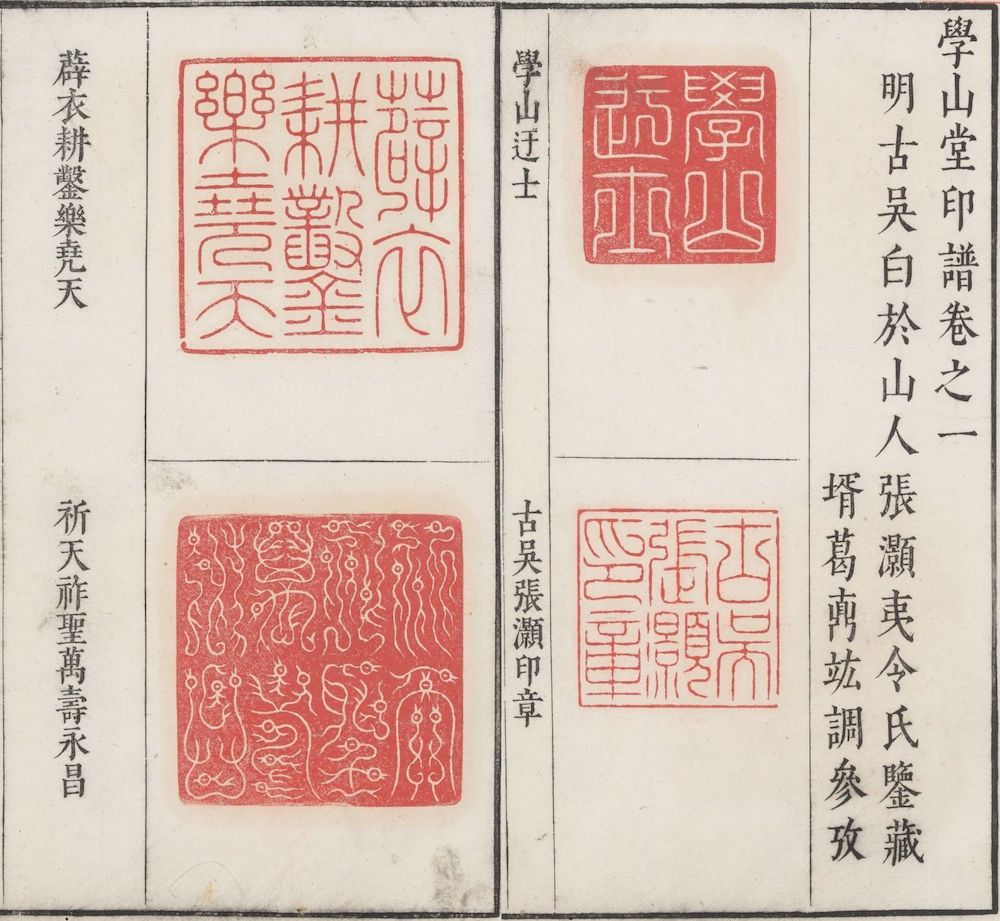Xueshantang yinpu 學山堂印譜 is a seal album compiled during the late Ming period 明 (1368-1644) by Zhang Hao 張灝, also called Zhang Su 張素 or Su Xiu 張休, courtesy name Jumin 古民 or Yiling 夷令 (also written 彝令), style Zhanggong 長公, Kanghou 康侯, Baiyu Shanren 白于山人, Koushishan Zhuren 扣石山主人, Xueshan Zhang 學山長 or Pingling Jushi 平陵居士 from Taicang 太倉 near Suzhou 蘇州, Jiangsu. He was the uncle of Zhang Pu 張溥 (1602-1641), leader of the famous Revival Society (Fushe 復社), and also wrote the catalogue Chengqingguan yinpu 承清館印譜, and a book called Yinshi 印史.
The first version of the Xueshangtang yinpu was finished in 1631. It consists of 5 juan distributed over 6 volumes, the first of which includes an array of 22 introductory prefaces written, among others, by Yang Rucheng 楊汝成 (jinshi degree 1625) and Gu Xichou 顧錫疇 (1585-1646). Of the main text, each page presents between 2 and 4 seals, with a total number of 1192 imprints. All seal-script texts are transcribed into regular script.
The second version of 8 juan and 10 volumes was published in 1634. It is a revised and enlarged version of the first edition. It includes the artworks of more than 50 contemporary seal carvers like Gui Changshi 歸昌世 (1573-1644), He Zhen 何震 (1541-1606), Su Xuan 蘇宣 (1553-1626), Zhu Jian 朱簡 (b. 1570), Liang Zhi 梁袠 (d. 1644) or Cheng Yuan 程遠 (fl. 1617). Most of them do not bear names or titles, but quotations from history books and literature. This version includes more than 2,000 imprints, with transcriptions and additional information on the collector or seal carver.
 |
From Guangming zhi men 光明之門. |
Compared with the Chengqingguan yinpu, the Xueshantang yinpu is much more reliable and valuable. It was therefore highly estimated among collectors and connoisseurs, as one of the "catalogues of the Three Halls" (santang yinpu 三堂印譜), the others being Zhang Lianggong's 周亮工 Laigutang yinpu 賴古堂印譜 (1612-1672), and Wang Qishu's 汪啟淑 (1728-1799) Feihongtang yinpu 飛鴻堂印譜.